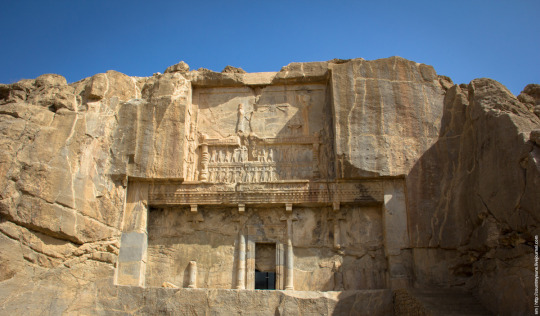#Tangeh Bolagni
Text
A treasure was found,by accident.
TEHRAN –Two climbers have found a rock-carved bas-relief on their way near the UNESCO-registered Pasargadae, southern Iran.

“Two climbers came across this inscription while climbing on their way near Tangeh Bolaghi in the Pasargadae region,” a local official in charge of the protection of cultural heritage said on Wednesday.
They immediately informed officials of the Pasargadae, the World Heritage site, Mehr reported.
“These two mountaineers, who asked not to be named, considered the historical relics to be a part of the past of this region, which belongs to all Iranians, and efforts should be made to preserve and protect them.
Experts say the inscription, which dates from the Sassanid era, is actually a dedicatory letter that informs about the construction of a bridge, dam, and road, and a blessing has been prayed for its builders.
Inscribed on a rack piece measuring 90 by 40 cm, the relief bears three separate texts with the same themes, all in the Pahlavi script.
Tangeh Bolaghi is an archaeologically significant valley, consisting of 130 ancient settlements, dating back to the period between 5,000 BC and the Sassanian dynastic era (224-651 CE). It is situated in the southern province of Fars, some seven kilometers from Pasargadae.
Archaeological research since 2005 has discovered a section of a former royal road connecting Pasargadae to Persepolis, Susa and other regions of the Persian Empire up to Sardis. Excavations have provided archaeologists with a unique insight into the lives of the people living in the Achaemenid dynastic era.
Pasargadae, which began under Cyrus the Great in about 546 BC, maybe more expanded than what is perceived from its ruins. “Archaeological evidence suggests that Pasargadae is beyond what we see. It was a summer residence, a recreational area with many gardens and buildings…,” according to Iranian archaeologist Ali Mousavi.
Situated about 50 km north of Persepolis, Pasargadae was the first dynastic capital of the Achaemenid Empire in the 6th century BC. Its palaces, gardens, and the mausoleum of Cyrus are outstanding examples of the first phase of royal Achaemenid art and architecture and exceptional testimonies of Persian civilization.
Pasargadae developed into a city of some significance until it was superseded by Darius I’s magnificent palace in Persepolis. The key sights on this isolated plain are the Tomb of Cyrus, Darius' Garden, and Cyrus' private palace. Around 500m north of Cyrus’ private palace is the remains of the Prison of Solomon (Zendan-e Soleiman), variously thought to be a fire temple, tomb, sundial, or store. On the hill beyond is the Tall-e Takht–a monumental 6000-sq-meter citadel used from Cyrus’ time until the late Sassanian period. Local historians believe the references to Solomon date from the Arab conquest when the inhabitants of Pasargadae renamed the sites with Islamic names to prevent their destruction.
The 160-ha archaeological site stands as an exceptional witness to the Achaemenid civilization. The vast Achaemenid Empire, which extended from the eastern Mediterranean and Egypt to the Indus River in India, is considered the first empire to be characterized by respect for the cultural diversity of its people. Experts believe that Pasargadae represents the first phase of this development, specifically Persian architecture, which later found its full expression in the city of Persepolis.

Source:https://www.tehrantimes.com/news/480467/Bas-relief-found-near-Pasargadae-by-accident
#Iran#ancient Persia#Iran Tehran#UNESCO#Pasargadae Iran#Iran Persepolis#پاسارگاد#UNESCO World Heritage#archaelogy#Zagros Mountain#Tangeh Bolagni#Achaemenid Empire#Cyrus the Great Persia#ایران#bas relief#کوههای زاگرس#Achaemenes#Tehrantimes#Cyrus the Great
3 notes
·
View notes